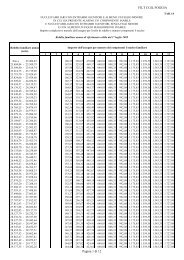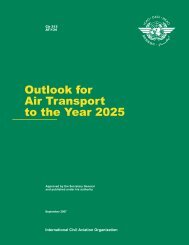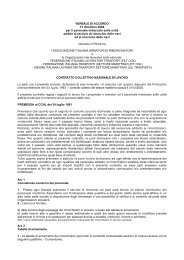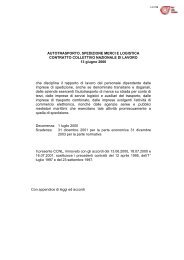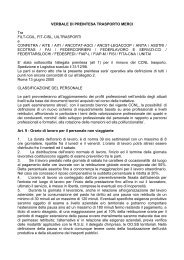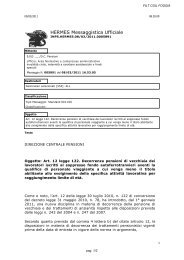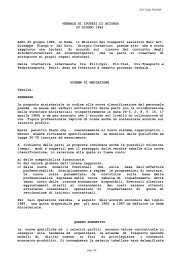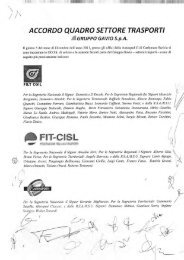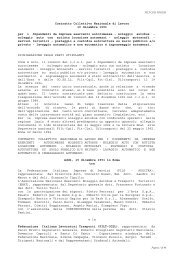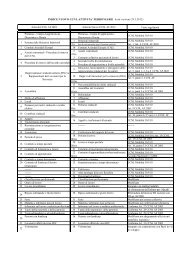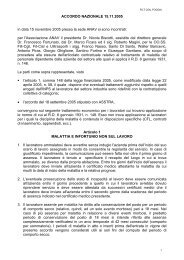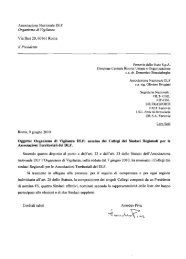Outlook for Air Transport to the Year 2015 - FILT CGIL Foggia
Outlook for Air Transport to the Year 2015 - FILT CGIL Foggia
Outlook for Air Transport to the Year 2015 - FILT CGIL Foggia
You also want an ePaper? Increase the reach of your titles
YUMPU automatically turns print PDFs into web optimized ePapers that Google loves.
Chapter 6FORECASTS OF AIRCRAFT MOVEMENTSTO THE YEAR <strong>2015</strong>FACTORS AFFECTING AIRCRAFT MOVEMENTS1. The planning of aviation facilities and <strong>the</strong> development of aviation policies require assessment of futuretrends in aircraft movements as well as of passenger and freight traffic flows. This is becoming increasinglyimportant because of concerns over airport and airspace congestion in some regions. <strong>Air</strong>craft movements havegrown steadily during most of <strong>the</strong> past decade, increasing <strong>the</strong> pressure on airport and air navigation services.Traffic declines since 2001 have somewhat eased this pressure in <strong>the</strong> regions concerned, but as traffic recovers,airport and airspace congestion are expected <strong>to</strong> build up again.2. The primary fac<strong>to</strong>r affecting <strong>the</strong> number of aircraft movements is <strong>the</strong> demand <strong>for</strong> passenger travel. Thepassenger traffic <strong>for</strong>ecasts presented in <strong>the</strong> previous chapter are, <strong>the</strong>re<strong>for</strong>e, key inputs <strong>to</strong> <strong>the</strong> aircraft movement<strong>for</strong>ecasts.3. When passenger demand increases, air carriers can respond by scheduling extra flights, by using largeraircraft, or by managing higher load fac<strong>to</strong>rs. During <strong>the</strong> 1970s, air carriers accommodated most of <strong>the</strong> growth indemand by introducing larger aircraft. As a result of both increasing aircraft size and improving load fac<strong>to</strong>rs, <strong>the</strong>growth in aircraft movements was quite small in <strong>the</strong> 1970s despite rapid growth in passenger traffic. However, in<strong>the</strong> 1980s, <strong>the</strong> trend in average aircraft size remained almost unchanged as airlines began <strong>to</strong> introduce more midsizeand smaller aircraft in<strong>to</strong> <strong>the</strong>ir fleets. From <strong>the</strong> early 1990s, <strong>the</strong> average aircraft size began <strong>to</strong> decrease and inrecent years, especially in 2001 and 2002, <strong>the</strong> decline has been more pronounced. Past trends in average aircraftsize and average load fac<strong>to</strong>r <strong>for</strong> <strong>to</strong>tal world scheduled services (excluding <strong>the</strong> Commonwealth of IndependentStates) are illustrated in Figure 6-1.4. Gradual improvements in average load fac<strong>to</strong>rs have resulted from marketing initiatives and yieldmanagement programmes, but <strong>the</strong>re is evidence that <strong>the</strong> rate of improvement in load fac<strong>to</strong>rs is slowing down.This is expected as <strong>the</strong> industry gradually approaches upper limits <strong>for</strong> load fac<strong>to</strong>rs, which are partially determinedby periodic and random variations in demand. In recent years, due <strong>to</strong> traffic declines, some markets experiencedexceptionally low load fac<strong>to</strong>rs. In order <strong>to</strong> remedy this situation, capacities were reduced on affected routes. As<strong>the</strong> load fac<strong>to</strong>rs have begun <strong>to</strong> show signs of progressive improvement, it is expected that <strong>the</strong> world averagescheduled passenger load fac<strong>to</strong>r, which increased from 66 per cent in 1992 <strong>to</strong> 71 per cent in 2002, will rise <strong>to</strong>about 73 per cent by <strong>2015</strong>.5. The services provided by carriers <strong>to</strong> meet demand result from a large number of decisions concerningnetwork structure, aircraft types and service frequency. These decisions depend on fac<strong>to</strong>rs such as <strong>the</strong> availabilityof traffic rights, <strong>the</strong> characteristics of alternative aircraft, and consumer preferences and trade-offs between priceand service quality. Despite <strong>the</strong> complexity of this process, it is possible <strong>to</strong> discern several key fac<strong>to</strong>rs which arein part responsible <strong>for</strong> <strong>the</strong> observed change in <strong>the</strong> trend in average aircraft size and hence <strong>the</strong> relationship betweentraffic demand and aircraft movements.6. The first of <strong>the</strong>se fac<strong>to</strong>rs is <strong>the</strong> trend <strong>to</strong>wards liberalization or deregulation in some important markets.Deregulation in <strong>the</strong> United States domestic airline markets began in 1978, followed by gradual liberalization of42





